This post may contain affiliate links at no additional cost to you. As an Amazon Associate I earn from qualifying purchases. Click to view our full disclosure.
What's inside
There are several good reasons to follow a 2000 calorie meal plan.
For men, 2,000 might be the right amount of calories to promote weight loss without affecting muscle mass. And for women, it might be the right number to support muscle growth.
No matter the reason, if you need help following a 2000 calorie meal plan, you’ve come to the right place.
As a registered dietitian, I know how difficult meal planning can seem. But in my many years of experience, those who plan ahead get the best results.
To make things easier for you, I’ve created several 2000 calorie meal plans. I’ve also included all of the recipes and grocery lists. Really, things couldn’t get any easier.
Now, before we begin, remember that these meal plans are made for educational purposes. They should never replace professional advice. Make sure you consult with a health professional to learn how many calories and macros you need based on your health, goals, and activity levels.
Until then, keep reading to get all those amazing 2000 calorie meal plans.
What is a 2000 calorie meal plan?
Read More: 2300 Calorie Meal Plan PDF
A 2000 calorie meal plan is a diet that offers an average of 2,000 calories daily.
The meal plans all include two snacks, breakfast, lunch, and dinner. While every day includes the same amount of calories, each plan varies in its macro distribution to meet different needs.
What does 2000 calories look like?
What 2,000 calories look like depends on the quality and composition of the ingredients you add.
Whole foods are going to be more filling and will provide more volume, while processed foods are higher in calories, and you might need a smaller serving to prevent you from overeating.
If you want to know what 2,000 calories looks like from a healthy diet, here is a one-day example.
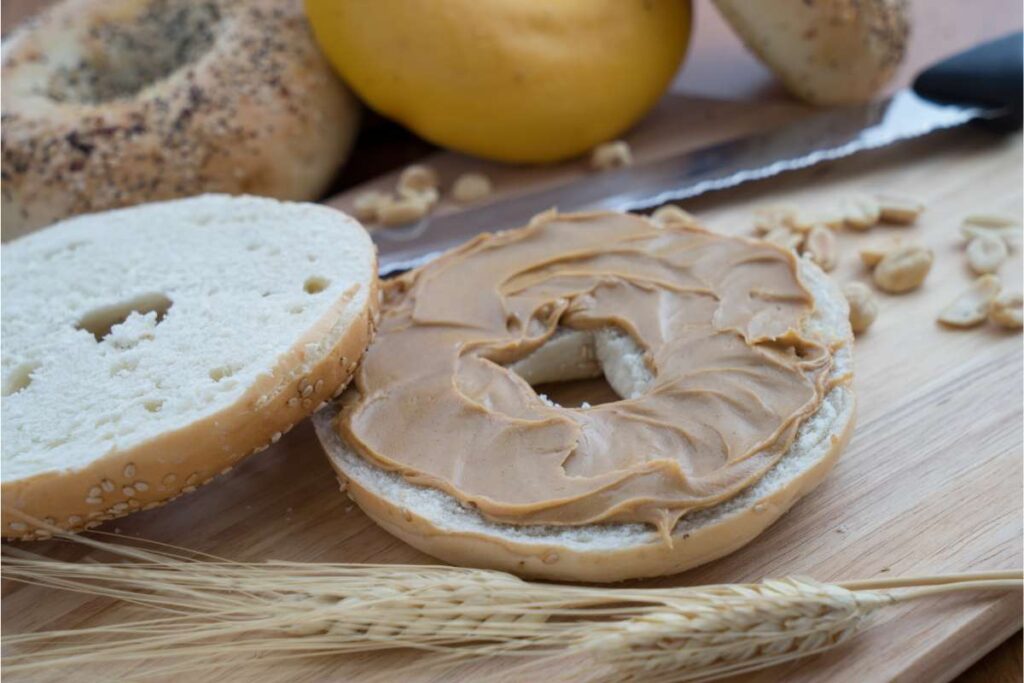
- Breakfast: Bagel and peanut butter
- Snack: Stone fruit salad with cottage cheese
- Lunch: Tofu spinach stir fry
- Snack: Hummus kraut and crackers
- Dinner: Chicken, broccoli, and mashed potatoes
Who should eat 2000 calories a day?
Read More: 2400 Calorie Meal Plan PDF
Men who want to lose weight all while maintaining their muscle mass can eat 2,000 calories a day. As long as you are in a caloric deficit (hopefully 20% less than the maintenance calories), it should be enough to contribute to healthy weight loss.
Now, women can also follow a 2000 calorie meal plan, but it is ideal for those who want to gain muscle mass. A 2000 calorie meal plan can help them reach a caloric surplus, which is essential for muscle gain.
Some women who are highly active (training every day for 1.5 to two hours) can use this meal plan to lose weight while maintaining muscle mass.
However, before you follow the meal plan, make sure you determine how many calories you need for your goals.
Is 2000 calories a day good?
Yes, 2,000 calories can be enough to provide essential nutrients and promote weight loss without excessive hunger or nutrient deficiency.
It can also be good for women who want to gain muscle mass with as little fat increase as possible.
What should be my calorie intake?
Related: 2100 Calorie Meal Plan PDF
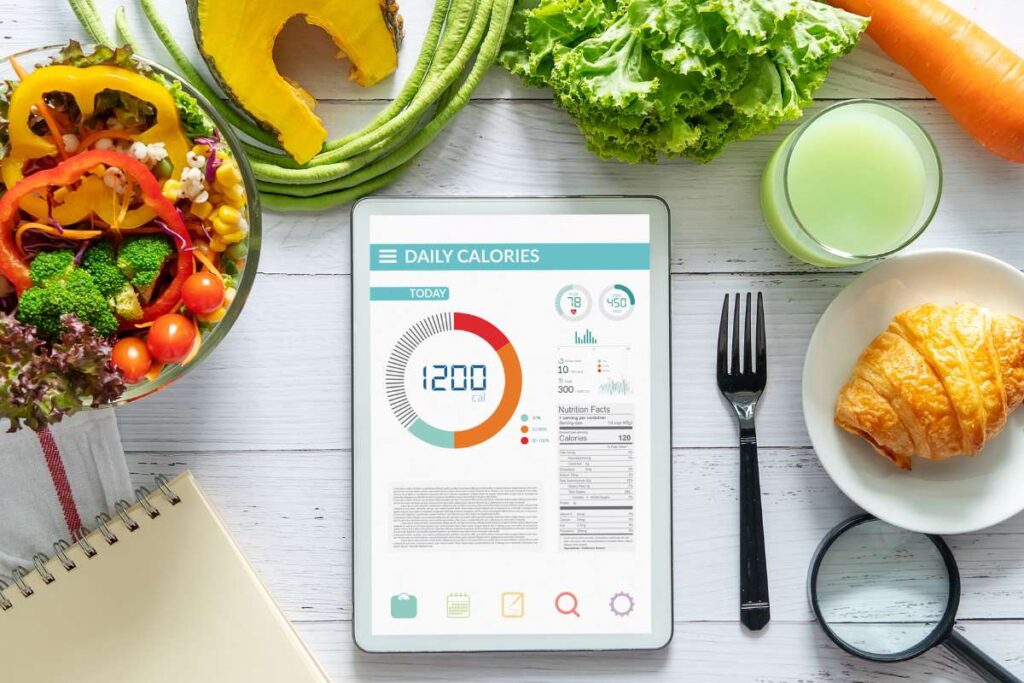
The number of calories you need depends on weight, height, age, activity levels, and goals.
A health professional can guide you on what is the recommended daily intake based on all the information above. If you are unable to see a health professional, a calorie and macro calculator can give you an idea.
Stay tuned, because I’ll share more about that coming up.
Benefits and Drawbacks of 2000 Calorie Meal Plan
If you do it correctly, there are big benefits to a structured meal plan like these. However, there are still some drawbacks you need to consider.
Benefits
- Weight Loss. A 2000 calorie meal plan can be enough to provide a healthy caloric deficit that won’t cause problems for the metabolism and still allow you to lose weight.
- Weight Gain. For some women, 2,000 calories is enough to provide a sustainable caloric surplus. It won’t provide too many calories that you feel stuffed at the end of the day or make you gain an incredible amount of fat.
- Portion Control. Knowing what you are going to eat and weighing it out can give you an understanding of how much food is right for the results you want. In addition, you get a grocery list to make things easier when you go shopping.
Drawbacks
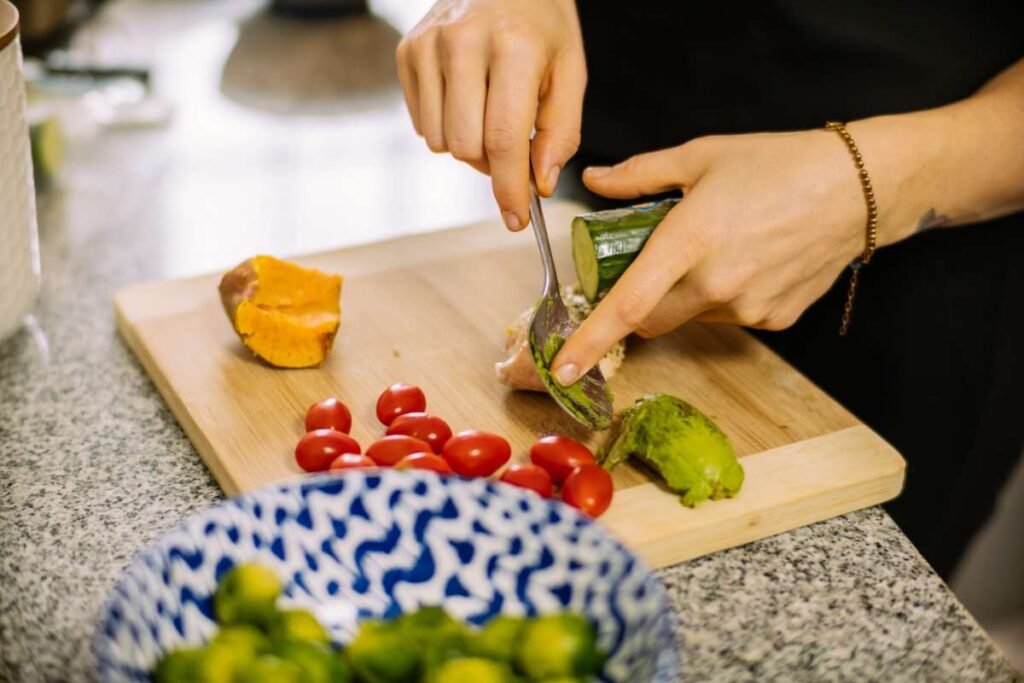
- Needs Cooking. One of the biggest drawbacks of this meal plan is that you do need to spend some time cooking. While there are ways to save time in the kitchen (like meal prepping), you still need to invest some time to create delicious meals that help you reach your goals.
- Weight Gain. If the meal plan is not accompanied by an adequate strength training routine, women following this meal plan might gain weight (mostly from body fat).
List of Available Dietary 2000 Calorie Meal Plans for Free Download
Before we get into the good stuff and talk about all those delicious recipes you get to download for free, here is a recap of the meal plans you can download.
They each contain the full recipes and grocery list.
- 7 Day Balanced 2000 Calorie Meal Plan PDF
- 21 Day Fix 2000 Calorie Meal Plan PDF
- 30 Day Balanced 2000 Calorie Meal Plan PDF
- 2000 Calorie Meal Plan 40/40/20 PDF
- 2000 Calorie Meal Plan 40/30/30 PDF
- 2000 Calorie Meal Plan 50/30/20 PDF
5 Tips for Following the 2000 Calorie Meal Plan
We’ve all been on diets we end up abandoning. How can you do this without crashing and burning? I know following a meal plan can sound too involved or be overwhelming.
Here are some tips and tricks that can make things easier for you.
- Start Meal Prepping

We are going to talk about the dreaded phrase people fear when following a meal plan. And that is meal prepping.
People tend to assume the worst of meal prepping. They think it takes too long, or that the food will sit around for days on end. But the truth is, meal prep is very adaptable to your preferences.
For some people, meal prep might mean making all the meals in advance. But you’ll still save time and prevent bad choices if you can only prepare only a couple of meals ahead.
Or, you can do what I call food prepping. This is where you only prep your ingredients for faster cooking later. This can include things like washing and cutting your produce.
- Know Which Foods To Eat
Getting familiar with the right food helps you determine which foods you can add more of and what allowable changes you can make to the meal plan.
If you are using this meal plan for weight loss purposes, protein and fiber are going to be your biggest allies. They both take longer to digest, increasing fullness levels. This makes it easier to reduce calories without feeling like you are starving the rest of the day.
On top of that, protein can also slightly increase metabolism and support muscle mass. Both play a crucial role in weight loss.
One of the benefits of following a meal plan is that you can make changes within the same food group. For example, if you don’t want to have chicken, you can exchange it for another protein that has similar nutritional value. You can also replace starches or vegetables.
In addition, you can also make changes within the same day. For example, you can have the lunch option for dinner and the other way around. As long as the changes are within the same day, they are fine.
- Know Which Foods To Avoid
The closer you stay to the meal plan, the better your results will be. Highly processed foods, such as pastries, cookies, fast food, sweets, soda, and processed meats are high in calories and can affect your results.
Instead, opt for fresh ingredients and minimally-processed foods to get more nutrients and a higher satiating effect.
- Pay Attention To Other Lifestyle Changes
Paying attention to calories is not the only important thing in weight loss. You also need to address sleep and stress.
Research shows that inadequate sleep and inability to handle stress can increase cravings, making it more challenging to follow a meal plan.
Make sure you are getting at least seven hours of high-quality sleep and are trying different ways to help you cope with stress.
- Drink Enough Water
Finally, drinking water plays a crucial role in weight loss. Evidence suggests that drinking water can help increase fullness levels, making it easier to follow a low-calorie meal plan.
Unsure how much water you need to drink? Divide your body weight by half (in pounds), and you’ll get the total ounces of water you need a day. For example, if you weigh 200 lbs, you should be drinking at least 100 ounces of water.
Macro Calculator
Not everyone is going to need 2000 calories a day. As mentioned, it all depends on your weight, age, height, activity levels, and goals.
If you are unsure how many calories you need, a health professional can guide you into what is the best action plan for you.
However, if you are unable to see a health professional, you can use our free calorie and macro calculator to give you an idea of how many calories and macros you need.
- Choose your training and nutrition experience: Beginner, moderate, or expert.
- Choose your tracking experience: Beginner, moderate, or expert.
- Tell us your age, weight, height, and body fat (optional).
- Choose your activity levels: Sedentary, lightly active, moderately active, heavily active, or athlete.
- Check your email for your results.
7-Day Balanced 2000 Calorie Meal Plan
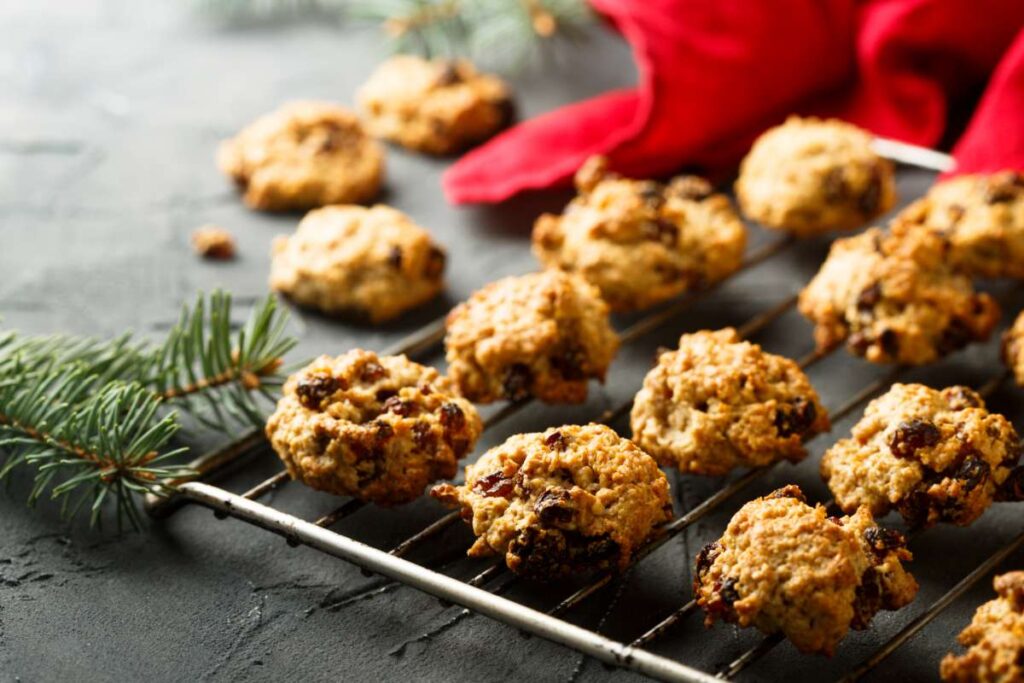
Starting this series we have this balanced 2000 calorie meal plan. It is ideal for those new to meal planning. It won’t make you feel overwhelmed since it’s only one week.
The following meal plan has a macro distribution of 50% carbs, 20% proteins, and 30% fats.
Monday
- Breakfast: Eggs and rice breakfast bowl
- Snack: Apple and cheddar quesadilla
- Lunch: Vegan lentil keema
- Snack: Strawberry banana chia pudding
- Dinner: Sesame chicken and noodle jar
Tuesday
- Breakfast: Eggs and rice breakfast bowl
- Snack: Apple and cheddar quesadilla
- Lunch: Sesame chicken and noodle jar
- Snack: Strawberry banana chia pudding
- Dinner: Chorizo and corn tostadas
Wednesday
- Breakfast: Eggs and rice breakfast bowl
- Snack: Apple and cheddar quesadilla
- Lunch: Chorizo and corn tostadas
- Snack: Strawberry banana chia pudding
- Dinner: Deluxe naan pizza
Thursday
- Breakfast: Chocolate-baked oats
- Snack: Cheesy black bean toast
- Lunch: Deluxe naan pizza
- Snack: Cinnamon raisin protein cookies
- Dinner: Snap pea and pancetta pasta
Friday
- Breakfast: Chocolate-baked oats
- Snack: Cheesy black bean toast
- Lunch: Snap pea and pancetta pasta
- Snack: Cinnamon raisin protein cookies
- Dinner: Baked beef and spinach rigatoni
Saturday
- Breakfast: Scrambled eggs with toasted bagel and peach
- Snack: Cheesy black bean toast
- Lunch: Baked beef and spinach rigatoni
- Snack: Cinnamon raisin protein cookies
- Dinner: Lasagna soup
Sunday
- Breakfast: Scrambled eggs with toasted bagel and peach
- Snack: Cheesy black bean toast
- Lunch: Lasagna soup
- Snack: Cinnamon raisin protein cookies
- Dinner: Fettuccine with sausage, beans, and kale
Ready to get started on this delicious meal plan? Click on the following link to get all the recipes for free.
7 Day Balanced 2000 Calorie Meal Plan PDF
21-Day Fix 2000 Calorie Meal Plan
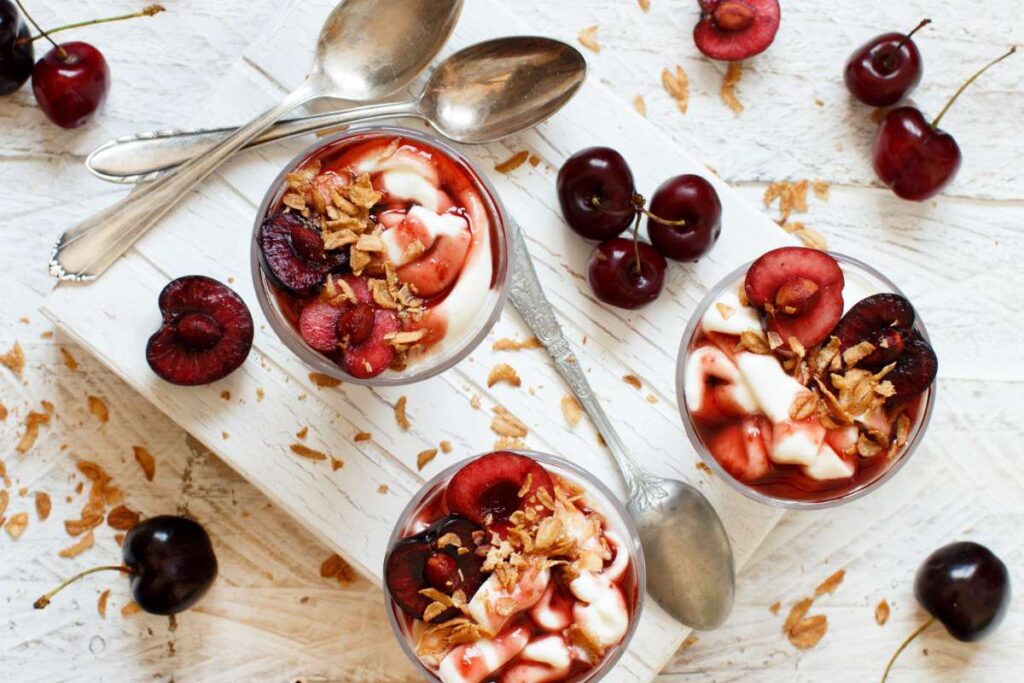
If you are up for the challenge, getting three weeks worth of meals won’t only get you great results, but it will make your life easier. By the time you’re through, you’ll be a meal planning pro.
The following plan has a macro breakdown of 50% carbs, 20% proteins, and 30% fats.
Monday
- Breakfast: Almond honey yogurt parfait
- Snack: Greek yogurt with almonds and pear
- Lunch: Black bean and quinoa Greek salad
- Snack: Spicy sardine and veggies toast
- Dinner: Galinhada
Tuesday
- Breakfast: Almond honey yogurt parfait
- Snack: Greek yogurt with almonds and pear
- Lunch: Galinhada
- Snack: Spicy sardine and veggies toast
- Dinner: Tahini, quinoa and roasted veggie bowl
Wednesday
- Breakfast: Almond honey yogurt parfait
- Snack: Greek yogurt with almonds and pear
- Lunch: Tahini, quinoa and roasted veggie bowl
- Snack: Spicy sardine and veggies toast
- Dinner: Pressure cooker cauliflower soup
Thursday
- Breakfast: Yogurt stuffed papaya
- Snack: Chocolate cherry chia pudding
- Lunch: Pressure cooker cauliflower soup
- Snack: Peach cobbler smoothie
- Dinner: Tofu broccoli pasta
Friday
- Breakfast: Yogurt stuffed papaya
- Snack: Chocolate cherry chia pudding
- Lunch: Tofu broccoli pasta
- Snack: Peach cobbler smoothie
- Dinner: Skillet lasagna
Saturday
- Breakfast: Banana and zucchini protein baked oats
- Snack: Chocolate cherry chia pudding
- Lunch: Skillet lasagna
- Snack: Peach cobbler smoothie
- Dinner: Elk enchilada bowl
Sunday
- Breakfast: Banana and zucchini protein baked oats
- Snack: Chocolate cherry chia pudding
- Lunch: Elk enchilada bowl
- Snack: Peach cobbler smoothie
- Dinner: Orzo with sausage and mushrooms
Ready to start making these delicious recipes? Click on the following link to get the instructions and grocery lists.
- 21 Day Fix 2000 Calorie Meal Plan Week 1 PDF
- 21 Day Fix 2000 Calorie Meal Plan Week 2 PDF
- 21 Day Fix 2000 Calorie Meal Plan Week 3 PDF
30-Day Balanced 2000 Calorie Meal Plan

It might sound overwhelming to plan for an entire month. However, what if I told you that you only need to download a PDF and you’ll get 30 days of meals?
Planning for a month can significantly reduce stress and make it easier to reach your goals.
The following month of meals has a macro distribution of 50% carbs, 20% proteins, and 30% fats.
Monday
- Breakfast: Peanut butter and berry toasted wraps
- Snack: Roasted chickpeas
- Lunch: Pinto bean quesadillas
- Snack: Apple and cheddar quesadillas
- Dinner: Black bean quinoa wraps
Tuesday
- Breakfast: Peanut butter and berry toasted wraps
- Snack: Roasted chickpeas
- Lunch: Black bean quinoa wraps
- Snack: Apple and cheddar quesadillas
- Dinner: Chicken, broccoli, and mashed potatoes
Wednesday
- Breakfast: Peanut butter and berry toasted wraps
- Snack: Roasted chickpeas
- Lunch: Chicken, broccoli, and mashed potatoes
- Snack: Apple and cheddar quesadillas
- Dinner: Air fryer falafel salad
Thursday
- Breakfast: Egg salad sandwich
- Snack: Edamame ricotta toast
- Lunch: Air fryer falafel salad
- Snack: Greek yogurt with almonds and pear
- Dinner: Spicy tofu and cauliflower soup
Friday
- Breakfast: Egg salad sandwich
- Snack: Edamame ricotta toast
- Lunch: Spicy tofu and cauliflower soup
- Snack: Greek yogurt with almonds and pear
- Dinner: Falafel wrap
Saturday
- Breakfast: Banana chocolate protein smoothie
- Snack: Edamame ricotta toast
- Lunch: Falafel wrap
- Snack: Greek yogurt with almonds and pear
- Dinner: Red curry poached cod
Sunday
- Breakfast: Banana chocolate protein smoothie
- Snack: Edamame ricotta toast
- Lunch: Red curry poached cod
- Snack: Greek yogurt with almonds and pear
- Dinner: One pan chicken thighs, fennel, and potatoes
- 30 Day Balanced 2000 Calorie Meal Plan Week 1 PDF
- 30 Day Balanced 2000 Calorie Meal Plan Week 2 PDF
- 30 Day Balanced 2000 Calorie Meal Plan Week 3 PDF
- 30 Day Balanced 2000 Calorie Meal Plan Week 4 PDF
2000 Calorie Meal Plan 40/40/20
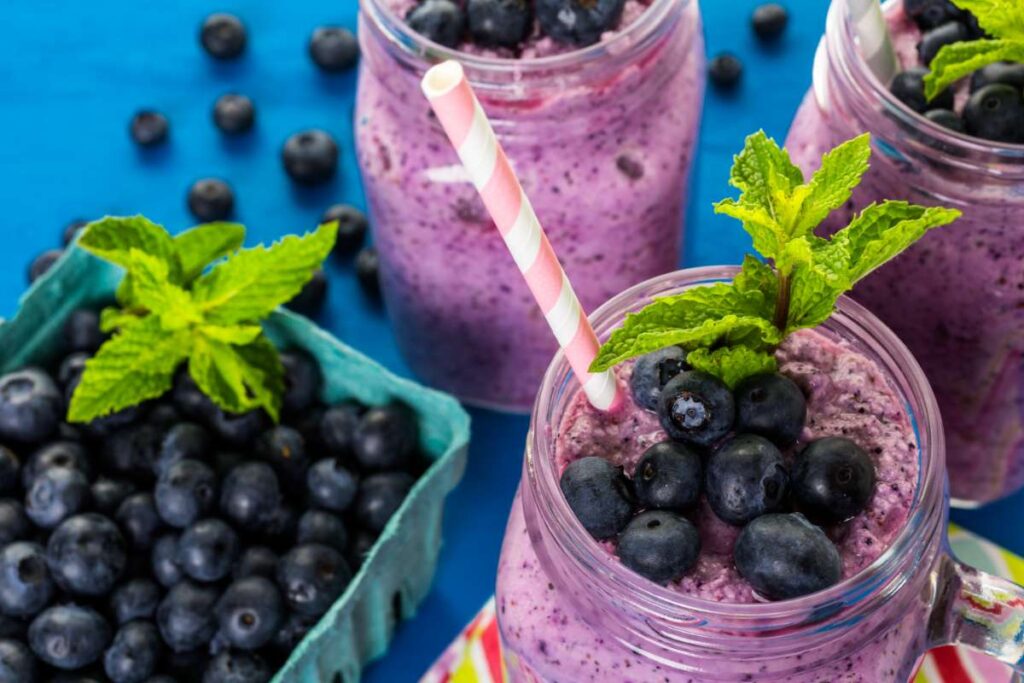
Some of you may require a low-fat diet. No matter the reason, remember that a low-fat diet should be followed only under medical supervision.
The following meal plan has a macro breakdown of 40% carbs, 40% proteins, and 20% fats.
Monday
- Breakfast: Creamy apple pie protein oatmeal
- Snack: Salmon burger bites with cucumber and pineapple
- Lunch: Turkey ranch mason jar salad
- Snack: Blueberry protein smoothie
- Dinner: Honey sesame chicken with peas and quinoa
Tuesday
- Breakfast: Creamy apple pie protein oatmeal
- Snack: Salmon burger bites with cucumber and pineapple
- Lunch: Honey sesame chicken with peas and quinoa
- Snack: Blueberry protein smoothie
- Dinner: Crispy haddock burger
Wednesday
- Breakfast: Creamy apple pie protein oatmeal
- Snack: Salmon burger bites with cucumber and pineapple
- Lunch: Crispy haddock burger
- Snack: Blueberry protein smoothie
- Dinner: Lentil, bean, and turkey chili
Thursday
- Breakfast: Tofu scramble with lentils and spinach
- Snack: Yogurt and berries
- Lunch: Lentil, bean, and turkey chili
- Snack: Mocha smoothie
- Dinner: Whole barbecued chicken and grilled potatoes
Friday
- Breakfast: Tofu scramble with lentils and spinach
- Snack: Yogurt and berries
- Lunch: Whole barbecued chicken and grilled potatoes
- Snack: Mocha smoothie
- Dinner: Tuna avocado sandwich
Saturday
- Breakfast: Mixed berry protein overnight oats and Greek yogurt
- Snack: Yogurt and berries
- Lunch: Tuna avocado sandwich
- Snack: Mocha smoothie
- Dinner: Salmon with rice and broccoli
Sunday
- Breakfast: Mixed berry protein overnight oats and Greek yogurt
- Snack: Yogurt and berries
- Lunch: Salmon with rice and broccoli
- Snack: Mocha smoothie
- Dinner: Beef shank and mashed potatoes
Ready to get the best results? Click on the following link to download the meal plan.
2000 Calorie Meal Plan 40/40/20 PDF
2000 Calorie Meal Plan 40/30/30
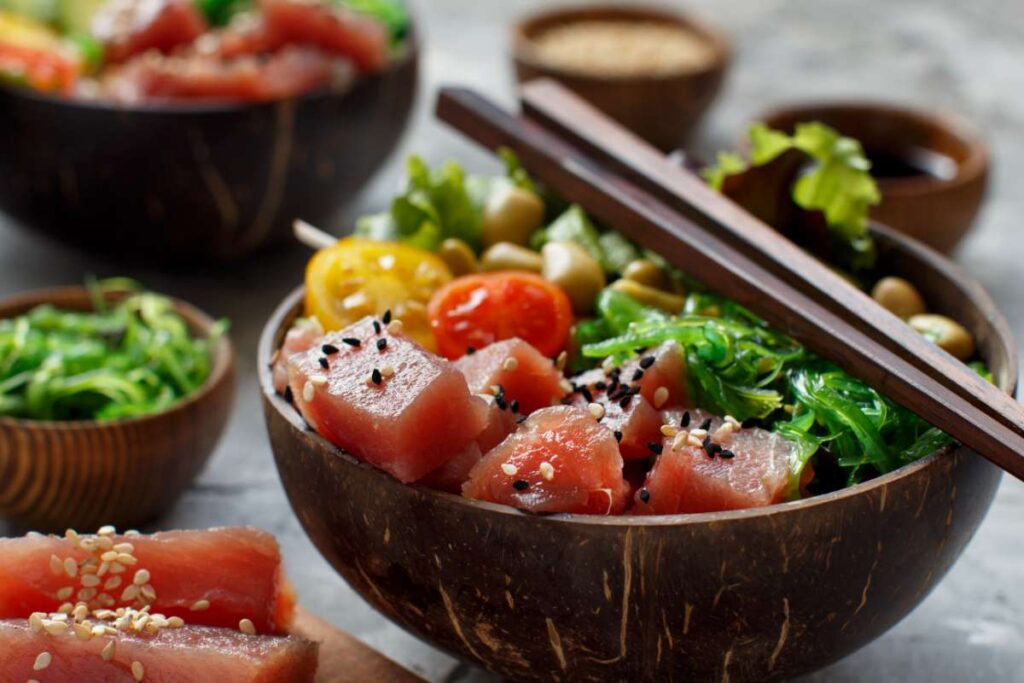
If you are using this meal plan as a weight loss strategy, a higher protein intake can help increase fullness levels throughout the day.
The following meal plan has a macro breakdown of 40% carbs, 30% proteins, and 30% fats.
Monday
- Breakfast: Winter yogurt bowl
- Snack: Cottage cheese and applesauce
- Lunch: Ahi tuna poke bowl
- Snack: Papaya breakfast bowl
- Dinner: Grilled tempeh and squash with rice
Tuesday
- Breakfast: Winter yogurt bowl
- Snack: Cottage cheese and applesauce
- Lunch: Grilled tempeh and squash with rice
- Snack: Papaya breakfast bowl
- Dinner: Pressure cooker Thai red curry beef
Wednesday
- Breakfast: Winter yogurt bowl
- Snack: Cottage cheese and applesauce
- Lunch: Pressure cooker Thai red curry beef
- Snack: Papaya breakfast bowl
- Dinner: Ginger peanut slaw salmon burger
Thursday
- Breakfast: Banana and zucchini protein baked oats
- Snack: Cottage cheese and mashed banana
- Lunch: Ginger peanut slaw salmon burger
- Snack: Chickpea and tomato savory yogurt bowl
- Dinner: Easy salmon poke bowl
Friday
- Breakfast: Banana and zucchini protein baked oats
- Snack: Cottage cheese and mashed banana
- Lunch: Easy salmon poke bowl
- Snack: Chickpea and tomato savory yogurt bowl
- Dinner: Beef and veggie skillet
Saturday
- Breakfast: Scrambled eggs with toasted bagel and peach
- Snack: Cottage cheese and mashed banana
- Lunch: Beef and veggie skillet
- Snack: Chickpea and tomato savory yogurt bowl
- Dinner: Spinach and tuna grilled cheese
Sunday
- Breakfast: Scrambled eggs with toasted bagel and peach
- Snack: Cottage cheese and mashed banana
- Lunch: Spinach and tuna grilled cheese
- Snack: Chickpea and tomato savory yogurt bowl
- Dinner: One pan chicken, chickpeas, and broccoli
Click below to begin:
2000 Calorie Meal Plan 40/30/30 PDF
2000 Calorie Meal Plan 50/30/20

The last meal plan in this 2,000 calorie series is higher in carbs, moderate in protein, and lower in fat. It is ideal for those who are highly active and need to replenish their glycogen stores while supporting muscle mass.
It has a macro distribution of 50% carbs, 30% proteins, and 20% fats.
Monday
- Breakfast: Cinnamon and banana protein oatmeal
- Snack: Peach cherry smoothie
- Lunch: Beef and veggie skillet
- Snack: Pineapple spinach smoothie
- Dinner: Lentil and chickpea pasta salad
Tuesday
- Breakfast: Cinnamon and banana protein oatmeal
- Snack: Peach cherry smoothie
- Lunch: Lentil and chickpea pasta salad
- Snack: Pineapple spinach smoothie
- Dinner: One pot beef, rice, and peppers
Wednesday
- Breakfast: Cinnamon and banana protein oatmeal
- Snack: Peach cherry smoothie
- Lunch: One pot beef, rice, and peppers
- Snack: Pineapple spinach smoothie
- Dinner: 15 minute shrimp puttanesca
Thursday
- Breakfast: Yogurt with granola and banana
- Snack: Peach, blackberry, and basil smoothie
- Lunch: 15 minute shrimp puttanesca
- Snack: Blueberry cobbler smoothie
- Dinner: BBQ salmon bowls with peach salsa
Friday
- Breakfast: Yogurt with granola and banana
- Snack: Peach, blackberry, and basil smoothie
- Lunch: BBQ salmon bowls with peach salsa
- Snack: Blueberry cobbler smoothie
- Dinner: Peanut and edamame chickpea pasta
Saturday
- Breakfast: Chocolate cauliflower shake
- Snack: Peach, blackberry, and basil smoothie
- Lunch: Peanut and edamame chickpea pasta
- Snack: Blueberry cobbler smoothie
- Dinner: Shrimp and smoked sausage spaghetti
Sunday
- Breakfast: Chocolate cauliflower shake
- Snack: Peach, blackberry, and basil smoothie
- Lunch: Shrimp and smoked sausage spaghetti
- Snack: Blueberry cobbler smoothie
- Dinner: Spaghetti with mussels
Did one of the recipes catch your eye? Click on the following link to get all the tasty recipes.
2000 Calorie Meal Plan 50/30/20 PDF
Benefits of Meal Planning
I know you’re probably tired of hearing this. But before we wrap this up, remember that there’s a reason dietitians like myself recommend sticking to a meal plan.
If you’re still not convinced that planning is worth it, consider this:
- Saves time and money. One of the best things about meal planning is that it takes all of the guesswork out of making the right decisions on the spot.
It really is as simple as clicking on a link. Plus, a little prep saves you time in the kitchen. It saves you money because you’re shopping from a list where ingredients can be bought in bulk. No impulse buys or unnecessary items!
- Reduces temptation. Imagine coming home from work exhausted. You are also hungry, and the best thing you can do is order a pizza because it’s fast and easy. And just like that, you’re off track.
Having meals or even just certain ingredients ready helps you avoid the temptation of ordering out. There are times you can plan for a “cheat” meal, but why not set yourself up for success throughout a busy week?
- Reduces stress. I know that making healthy decisions can be stressful, especially if they involve having to cook all of the time. However, since you already planned ahead, it is as simple as taking the meal out of the fridge (or freezer) and heating it up.
That’s one less thing to worry about, and your results are still on the way.
Conclusion
We’ve reached the end of this 2000 calorie meal plan series.
To recap, this type of meal plan is ideal for men who want to lose weight without having a negative impact on muscle mass. Women who are trying to gain muscle mass can also use this meal plan.
Now, not everyone is going to need 2000 calories. So, before you follow any of these meal plans, check with a health professional. They can identify how many calories you need, or you can use a calorie and macro calculator.
Which of the recipes are you excited to try? Let us know in the comments.
Frequently Asked Questions
How to eat 2000 calories a day?
To eat 2000 calories a day, have a balanced and varied diet.
While it might vary from person to person, aim to eat breakfast, lunch, dinner, and a couple of snacks. Make sure you are balancing all the macros (carbs, proteins, and fat).
If you are having difficulty reaching this intake, you can make high-calorie smoothies (milk, fruit, oatmeal, and honey).
Are 2000 calories too much?
No, for men it can be an ideal caloric intake to aid in weight loss. For women, it might be too many calories if you don’t accompany it with an adequate training program.
Make sure you check with a health professional how many calories you need based on weight, height, age, and activity levels.
How much food is 2000 calories?
It depends on the foods you include. But a typical 2000 calorie meal plan day would look like this:
Breakfast: Toast with nut butter, banana, and hemp seeds
Snack: stacked veggie sandwich
Lunch: Fiddlehead and edamame pesto pasta
Snack: peanut butter and blueberry toast
Dinner: Fajita spiced tofu and rice
How much should I be eating to lose weight?
It depends on your age, weight, heigh, activity levels, and goals. Consult with a health professional to determine how many calories you need to lose weight, or use our free calorie and macro calculator.
What food should I eat to gain 2000 calories a day?
Whole, nutritious foods with the right macro distribution for your needs are the best way to consume 2,000 calories daily.
If you have trouble getting this amount of calories, consider trying nut butters, protein powder, and avocados for a caloric boost.
Is it possible to lose weight eating 2000 calories a day?
Yes, if you are in a caloric deficit (eating fewer calories than the body needs), you can lose weight by following a 2000 calorie meal plan.
How much weight can you lose on a 2000 calorie diet?
It depends on your initial weight and how much weight you need to lose. But on average, you can lose one to two pounds a week on a 2000 calorie meal plan.
Remember that slow and steady wins the race. Aggressive weight loss might result in muscle loss.
How much weight can I gain eating 2000 calories a day?
You can gain half a pound to one pound by eating a 2000 calorie meal plan. However, for this to happen, you need to have the right exercise program.


